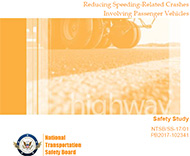8/17/2017
NTSB Pushes For Lower Speed Limits, Photo RadarNational Transportation Safety Board issues report claiming lower speed limits enforced by speed cameras will reduce accidents.

The National Transportation Safety Board (NTSB) on Tuesday released the final version of the government panel's examination of trends in automobile accidents related to speeding. A summary version had been distributed to news media last month with a recommendation that states nullify existing bans on automated enforcement in favor of unlimited use of photo radar.
The more detailed version of the NTSB work shows that the underlying definition of "speeding" continues to include situations in which a vehicle is not, in fact, exceeding the speed limit.
"The traffic safety community, including the National Highway Traffic Safety Administration, considers drivers to be speeding if their vehicles are traveling at a speed that (1) exceeds the speed limit or (2) is too fast for conditions" the NTSB report explained.
Driving too fast for the conditions can, for example, refer to someone driving at or below the speed limit in tricky conditions. The NTSB report's authors prominently cited just such an incident. On February 14, 2003, a 1996 Dina Viaggio motorcoach was traveling at 65 MPH in a 70 MPH zone on Interstate 35 near Hewitt, Texas. Fog and heavy rain obscured the driver's view of the road as the traffic ahead began to slow significantly. The bus driver hit the brakes, lost control, and spun into the opposite lane of traffic. Five died in the incident.
The vast majority of NTSB speed-related crash investigations involve commercial trucks and buses, and the agency believes the wet-weather bus crash in Texas could have been prevented by lowering the speed limit on Interstate 35, which would result in more automobile drivers receiving speeding tickets.
By including non-speed limit related incidents in its figures, the NTSB report expands the number of "speed related" crashes to 31 percent of fatalities. Deeper within the report, the exact figures are broken down and only 7.7 percent of the vehicles were actually identified as exceeding the speed limit. This is consistent with NHTSA statistics released last week showed only 7 percent were classified as exceeding the speed limit in 2015 (view report).
State-level data also show that only 1.6 percent of all accidents (including non-fatal) involved exceeding the posted speed limit (view report). In a 2008 report, NHTSA researchers identified other factors, such as loss of control or driver distraction as being far more likely to be a factor in road accidents than exceeding the speed limit (view report). The NTSB study did not consider these factors.
"The national crash databases used for this study do not indicate the probable cause of a crash," the NTSB report noted. "This study generally does not consider the many other factors that cause crashes and crash-related injuries, such as distraction or drug impairment."
The NTSB report calls for lowering speed limits by questioning the long-standing engineering principle of basing speed limits on the 85th percentile speed rule -- that is, the speed at which the vast majority of free-flowing traffic is found to safely proceed along a road. As justification for the shift, the report cites research by the Insurance Institute for Highway Safety (IIHS), an organization funded by insurance companies that collect billions in surcharges from motorists who receive speeding tickets.
The NTSB based its findings on interviews with stakeholders consisting of federal transportation agency officials, transportation officials in a dozen states, five state highway patrol supervisors, seven local police department officers and seven city transportation department officials and proponents of Vision Zero. Four US automakers were interviewed, but only about "technologies designed to prevent unsafe behaviors by teen drivers." Representatives from speed camera vendors, traffic ticket advocacy groups and insurance companies also provided input.
The NTSB report is available in a 2.7mb PDF file at the source link below.


